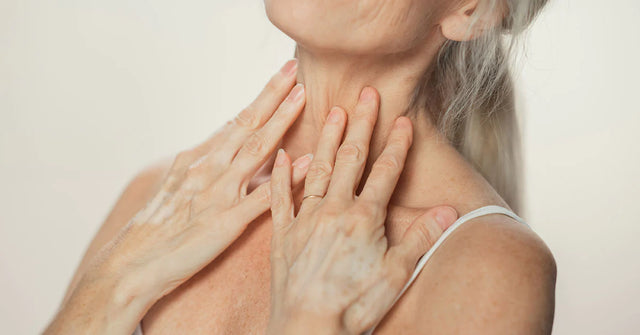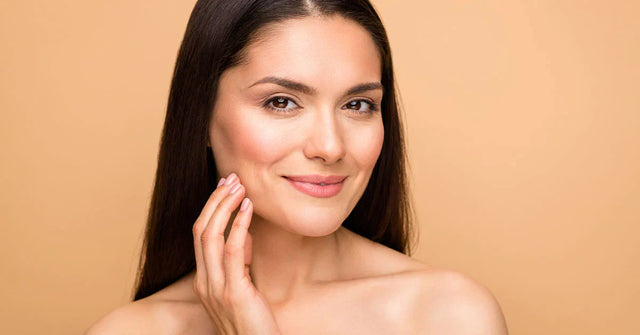We’ve all been there. No matter where or when you’ve experienced dry skin, it’s incredibly uncomfortable and unsettling. However, it’s a new level of discomfort when dry skin appears around the eyes.
On days when it feels like even the most effective moisturizer in the world can’t cure your dry skin blues, hope prevails. When it comes to how to treat dry skin around the eyes, understanding the symptoms and causes can help you tackle it.
You’ll need a specific treatment for managing dry skin around the eyes as regular moisturizers often don’t cut it. Here’s our ultimate guide on what to do for dry skin around the eyes and banish it forever.
What Are the Symptoms of Dry Skin Around the Eyes?
Our eyes are one of the first things people notice about us. When dry skin appears around the eyes, it can spark feelings of insecurity or self-consciousness.
Symptoms of dry skin around the eyes are usually fairly obvious, but they typically appear as the following:
- Red, irritated or damaged skin
- Itchy, dry, or flaky skin
- Burning or stinging when products are applied
- Rash-like symptoms
- Swelling or crusted eyes
- Cracked watery skin
What Causes Dry Skin Around the Eyes?
Dry skin around the eyes can be a result of a variety of different things. However, dry skin around the eyes should be taken seriously, as it can be a sign of serious infections or conditions that require immediate intervention.
Conjunctivitis
One of the leading causes of dry skin around the eyes is conjunctivitis, more commonly known as pink eye. It occurs when the outer membrane of the eyeball itself becomes infected. Conjunctivitis can cause redness, swelling, and dryness.
Blepharitis
Blepharitis occurs when the eyelid or eyelashes become inflamed. It causes tenderness, swelling, dryness of the eyelids, and crusty flakes at the base of the eyelashes. Most cases are mild to moderate but always require immediate intervention.
Eczema
Eczema is a common skin condition that causes dry, itchy, flaky skin. It’s usually normal for it to occur on the eyelids. Eczema is considered a lifelong condition and can cause flare-ups. While there is no cure, it is easily manageable with diligent treatment. If you’re struggling with skin peeling due to eczema, it might be time to consult your doctor or dermatologist.
Eyelid Dermatitis
Dermatitis can occur anywhere on the body, but it’s especially noticeable in the eyes, which can be incredibly disconcerting to those experiencing it. It’s usually a reaction to an ingredient or product and is the first sign of an allergy. It can cause the skin to look dry, ashy, red, swollen, or flaky. Often, it appears like a dry patch on the eyelid. It usually requires medical intervention with topical creams.
Ocular Rosacea
If you have rosacea with flaky dry skin around the eye, you might have ocular rosacea. Ocular rosacea is a specific type of rosacea that affects only the eyes. It can cause redness, burning, and itching. Furthermore, if you start to get red spots under your eyes, that can also be an indication of ocular rosacea.
Other Factors
While this list isn’t exhaustive, other skin conditions can present similarly. Things like allergies and autoimmune disorders can aggravate dryness around the eyes. In addition, you should always consult a medical professional if you’re experiencing dry skin around the eyes.
How to Treat Dry Skin Around the Eyes
Now that we’ve established the symptoms and causes, it’s time to delve into what to do for dry skin around the eyes. Luckily, there are common treatments, home remedies, and preventative measures to beat dry skin. Though it can be disconcerting, dry skin is one of the easiest things to remedy in the skincare world.
Here’s a list of how to instantly soothe dry irritated skin around the eyes:
Common Treatments
Treatments for dry skin around the eyes are usually available over the counter. It also requires minimal lifestyle changes or is available within your own home!
Get Good Sleep
We know that good sleep is vital for our health and well-being. However, it’s also essential for our eye health. Our eyes and other organs cannot function properly without adequate sleep. Aiming for seven to nine hours of sleep can help alleviate dry skin around the eyes. After all, sleep is the most important step of your PM skincare routine!
Implement a Skincare Routine
If you don’t have a proper skincare routine lined up, your eyes may suffer the consequences, resulting in surface dryness. Regularly cleansing and moisturizing your eyes with gentle products reduces the risk of dryness and irritation. If you’re especially concerned about dryness, check out our guide on the ultimate skincare routine for dry skin.
Use Sunscreen
When the skin is exposed to UV rays, it can quickly become sunburned, resulting in dryness, peeling, flaking, and irritation. The eye is not exempted from this. In fact, since the skin around the eye is naturally thinner, it’s much more prone to the effects of UV rays. Wearing sunscreen every day can help protect your eyes against harmful sun exposure. Dermaxsol is a lightweight hydrating cream with SPF30 that protects the skin from UVA rays. After all, SPF is the most important part of your AM skincare routine.
Don’t Forget to Apply Eye Cream
Without a healthy skin barrier, our skin is left vulnerable to elements and environmental aggressors. Skipping moisturizer is one of the most harmful things you can do when it comes to maintaining the skin barrier. Regularly moisturizing can be a very effective way to reduce surface dryness and fortify your skin barrier.
Regular use of eye cream can help protect the delicate skin around the eye. Our Eyevage Anti-Aging Eye Cream uses soy and rice proteins, hyaluronic acid, and squalane to intensely nourish and hydrate the eye area. Eye creams work as both a treatment and preventive solution against surface dryness.
Use Essential Oils
Lavender, tea tree, and chamomile essential oils can be helpful in battling dry skin. They work best when diluted to help smooth and clarify irritated skin. When it comes to essential ingredients for dry skin, it’s no surprise that essential oils are one of the top choices.
Topical Corticosteroids
Topical corticosteroids are incredibly useful and effective in treating dryness around the eyes. They work by reducing inflammation and hypersensitivity. Consider topical corticosteroids if the dry skin around your eyes is progressively getting worse.
Humidifier
Humidifiers, when used with moisturizing products, can help reduce surface dryness. They can also soothe existing irritation. Regular use of humidifiers can help replenish moisture levels if used with an eye cream and hydrating serums. This can be especially soothing for the eye area.
Preventing Dry Skin Around the Eyes
As with most skincare concerns, prevention is key to long-term results. Sticking with your routine and healthy lifestyle will give you noticeable results. Preventing dry skin around the eyes is no different than treating breakouts or hyperpigmentation. For example, if you notice that makeup products irritate the skin of your eyes, don’t use them. Prevention is also about avoiding potential triggers.
Here are our top tips for preventing dry skin around the eyes:
Manage Your Stress Levels
Stress can manifest in skin dryness or wrinkling. When we’re stressed, our skin can break out in rashes and hives, which can result in a lack of moisture. Managing stress levels can help mitigate dry skin. Exercising, getting enough sleep, and limiting unnecessary stress can ensure your skin is functioning properly.
Don’t Rub Your Eyes
We touch many surfaces, public items, and suspect things throughout the day. Transferring bacteria from high-traffic areas to our eyes is one surefire way to get an eye infection and a rash that can result in dry skin. Therefore, avoid touching and rubbing your eyes at all costs. If necessary, wash your hands before touching your face, especially your eyes.
Choose Gentle Skin Products
Sometimes, the simplest is the most effective. If the skin around your eyes is growing increasingly reactive, it might be time to go back to the basics. Often, when skin is exhibiting signs of irritation, it’s best to use gentle products to help improve skin barrier function. Opt for a gentle cleanser, moisturizer, and sunscreen until the dry skin around your eyes subsides.
FAQs: How to Treat Dry Skin Around the Eyes
How do you fix dry skin around the eyes?
Since there are many potential causes of dry skin, it's best to keep your routine simple, concentrate on sun protection, and seek medical advice.
Can I put moisturizer under my eyes?
While there isn’t necessarily anything wrong with applying moisturizer under your eyes, it’s recommended to use an eye cream. Since the skin around the eyes is very thin, it needs delicate moisture.
Is Vaseline good for dry skin under the eyes?
Vaseline works as an occlusive to lock in existing moisture and soothe irritation, which can help alleviate dry skin concerns. As long as you’ve cleansed the area thoroughly, it’s safe to use Vaseline under the eyes.
Key Takeaways
Dry skin can be uncomfortable, especially around the eye area. Even though it's often a sign of an infection or skin disease, taking precautions can ease discomfort.
Treating dry skin around the eyes doesn’t have to be complicated. With some extra TLC, medical guidance, and the right products, your skin will bounce back to normal in no time!
Mentioned in this article
More stories

Loose Neck Skin After 50: Causes and Solutions







